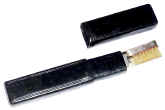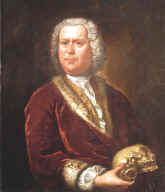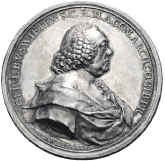21. A c. 1650 English antique silver blade for administering a plaster to treat wounds. The punch mark is AA, probably the London silversmith's double-A mark on a 1635-6 communion cup listed in Jackson's Silver and Gold Marks, 1989, p. 117. The instrument is identified as a combination spatula and tongue depressor. One side of the spatula blade is flat to apply a plaster, while the other is beveled to aid fanning-out the plaster. At the opposite end is speculum lingua and its decorative pattern of fenestration dates to at least as early as the sixteenth century (Raimund Laminit, about 1520 to 1600, Augsburg) and was said by John Woodall (1617) to better hold the tongue. The identical shape and open-work design of the piece offered are also seen on the only known twin of this instrument that is found in the Wellcome Collection. The Wellcome example also appears to have the punch mark AA.
A mate 17th century silver instrument similar decoratively pierced tongue depressor matched with a tongue scraper. This 17th century medical tool is stamped with an R. The only other known example of this pairing and period style, which apparently survived in its original shagreen box with other instruments, first published in a 1956 issue of Country Life, is now held by the Royal College of Surgeons of England.
The illustration of a twin piercing on a spatula lingua and tongue 'furring' scraper is from James Cooke, Supplementum chirurgiae, London, 1655.
Seventeenth century silver medical instruments are extremely rare. $8,000


22. A fine Georgian antique dental hygiene set with silver toothbrush, toothpowder box with double-hinged lid, and tongue scraper contained within a leather two-piece case. The silver hallmarks are for William Pitts, London, 1791. $2,750
23. An extensive and exquisite set of c. 1820 antique minor surgery instruments by Maison de Henry, Paris. Henry, who was fabricant-aciériste et coutelier de la Faculté de médecine de Paris, also went by the name Sir-Henry and had a retail establishment on the Rue de l'École-de-Médecine, Paris. In 1825 Henry published: Précis descriptif sur les instrumens de chirurgie anciens et modernes. Plates 1. and 2. exactly illustrate various instruments in this surgical trousse. Many pieces are solid silver, including the catheters, bandage forceps, érigne (double-grasping hooks with sliding-ring lock), scissors (not the blades), spatula, and tweezers. The silver is hallmarked L S with a chalice between the initials, the mark of Sir Henry as registered in 1810-1811. Here is a high quality King Louis XVIII period antique set of surgical instruments. $2,500
24. An oil on canvas mid-18th century painting of a doctor holding a skull. The doctor tilts the skull to show its underside to the viewer as if remarking on details of the human skull. The c. 1750 portrait is of Dr. Gerard van Swieten (1700-1772). Van Swieten was a student of Hermann Boerhaave (1668-1738) and he compiled a 5 volumes Commentaria in Hermanni Boerhaave Aphorismos de Cognoscendis et Curandis Morbis, which were based upon over 20 years of notes taken while attending Boerhaave's medical lectures. In 1745 Dr. van Swieten was appointed the personal physician to Empress Maria Theresa of Austria (1717-1780). Dr. van Swieten is known to Dracula enthusiasts as the doctor who investigated the legitimacy of vampires in Moravia. The Dr. Abraham van Helsing character in Bram Stoker's novel Dracula is loosely based upon van Swieten. The medal dates to 1756, about the same time as the portrait. The marble bust of Gerhard van Swieten is in the Austrian National Library, Vienna, and was sculpted c. 1770. The photo of the bust is courtesy of Politikaner. The Gerard van Swieten painting is ex New York Academy of Medicine. $25,000
25. A very rare British royal antique bourdaloue (female chamberpot) in silver with original leather case. Several indistinct Continental marks are stamped into the interior near the base on one side at an old repair. A dog's head facing right and a script letter H or L appear to be the two touchmarks. Both the antique coach pot or bourdaloue and case display the British royal coronet of four crosses-patée and four fleurs-de-lis alternately Or (only three crosses and two fleurs-de-lis visible) and the letters L F, which crossover one another. According to the College of Arms, London, the cipher is that of Her Royal Highness Princess Louise Victoria Alexandra Dagmar, Duchess of Fife (1867-1931). She was the eldest daughter of King Edward VII, and, in 1905, she was created The Princess Royal. For her biography, please see this link. It is highly unusual to see in the market an antique silver bourdaloue, let alone one associated with a Princess Royal. Gardyloo! $9,500
26. A c. 1850 antique écraseur by Charrière, Paris, cased in its original box. The steel is unplated and the handle is ebony. This model of an antique chain écraseur is of Charrière's own design. $1,250
27. An English c. 1760 antique bloodletting thumb lancet with blade stamped with the State Crown as modified for the coronation of George II in 1727. The hallmark is probably that of Evans, a London surgical instrument maker and noted source for thumb lancets. A most unusual aspect of this lancet is the solid rose gold covers; no other example is generally known. The family crest of Ponsonby is expertly engraved on one scale. The crest is composed of a ducal coronet (a customary coronet used in crests) surmounted by three arrows, signifying readiness, that are threaded by a snake, a symbol of wisdom. By family tradition the prime ancestor of the Ponsonbys had taken part in the Norman conquest of England by William the Conqueror and, in 1177 during the reign of Henry II, the family had been conferred with the office of Barber to the King, one of the close aides to the king and a financially and politically advantageous position. To reflect this connection between the monarchy and the line, the Ponsonby coat-of-arms, created c. 1740, sports three combs. A likely candidate for the original owner is William Ponsonby, the 2nd Earl of Bessborough (1704-1793). $950

















